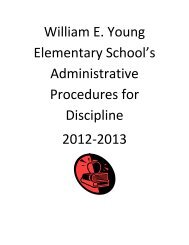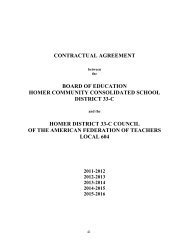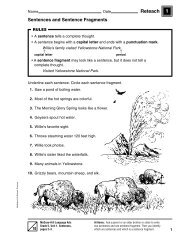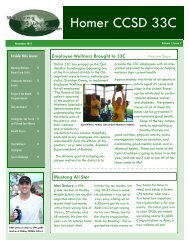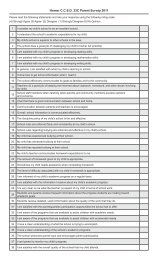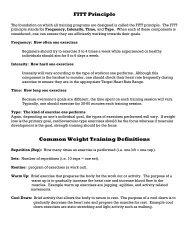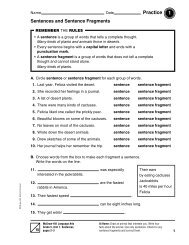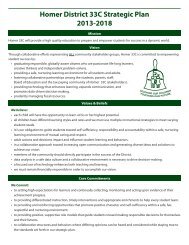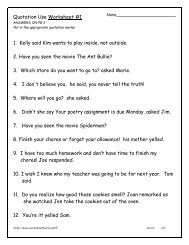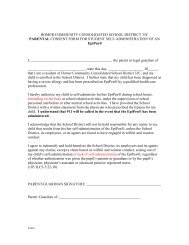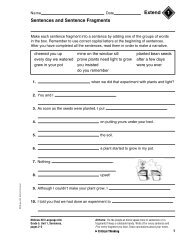Survival Guide for Parents of New Wrestlers - Team Rhino LLC
Survival Guide for Parents of New Wrestlers - Team Rhino LLC
Survival Guide for Parents of New Wrestlers - Team Rhino LLC
Create successful ePaper yourself
Turn your PDF publications into a flip-book with our unique Google optimized e-Paper software.
own his legs back. From this position, he will try to gain control, <strong>for</strong> example by running<br />
behind the other wrestler, or by using a trip or throw. Whichever wrestler gains control<br />
earns two point <strong>for</strong> a takedown and has the position <strong>of</strong> advantage. The wrestler with the<br />
advantage is called the <strong>of</strong>fensive wrestler; his opponent is called the defensive wrestler.<br />
Once a wrestler has the advantage, his goal is to turn his opponent's back to the mat in<br />
order to earn a pin. If one wrestler pins his opponent, the match is over and the <strong>of</strong>fensive<br />
wrestler wins by fall. There are many, many moves that wrestlers use to accomplish this.<br />
The headlock (locking your arms around the opponent's head and one arm), half nelson<br />
(placing your arm under the opponent's elbow and on his head, then lifting the elbow<br />
while pressing the head down), and cradle (locking your arms around the opponent's<br />
head and one knee), are a few you'll see commonly. Some <strong>of</strong> these moves require that the<br />
defensive wrestler be flat on his torso, so the <strong>of</strong>fensive wrestler will <strong>of</strong>ten try to break<br />
him down. If the <strong>of</strong>fensive wrestler turns his opponent and holds his shoulders to the<br />
mat <strong>for</strong> two seconds, he earns a victory by fall. If he cannot accomplish this, but he is<br />
able to expose his opponent's shoulders to the mat <strong>for</strong> longer than reaction time, the<br />
<strong>of</strong>fensive wrestler is awarded a near fall. Holding this position <strong>for</strong> two seconds earns 2<br />
points, while holding it <strong>for</strong> five seconds earns 3 points. These points are also called back<br />
points <strong>for</strong> obvious reasons.<br />
While the <strong>of</strong>fensive wrestler tries to earn back points or get a pin, the defensive wrestler<br />
is busy, too. His goal is to either get free from his opponent's control (called an escape)<br />
or to gain the advantage himself (called a reversal). An escape earns 1 point while a<br />
reversal earns 2. A defensive wrestler can use any number <strong>of</strong> moves, too. He can turn his<br />
back to the <strong>of</strong>fensive wrestler and either sitout or standup by pressing his back against<br />
his opponent's chest, shoulders, or head, or he might try a switch, in which he spins<br />
around the side <strong>of</strong> the <strong>of</strong>fensive wrestler. If the defensive wrestler escapes, then there is<br />
no advantage, and the match continues in the neutral position, just as at the start. If there<br />
is a reversal, the wrestlers pursue their new goals: the new <strong>of</strong>fensive wrestler tries to<br />
turn his opponent and the new defensive wrestler tries to escape or reverse.<br />
While all <strong>of</strong> this is going on, the wrestlers must stay in bounds. If the supporting parts<br />
<strong>of</strong> both wrestlers are out or bounds, the referee will stop the match. If neither wrestler<br />
had as advantage, then the match will resume in the middle <strong>of</strong> the mat just as at the start.<br />
If one <strong>of</strong> the wrestlers had an advantage, then the wrestlers will assume the referee's<br />
position. In this position, defensive wrestler will kneel on his hands and knees, then the<br />
<strong>of</strong>fensive wrestler will squat next to him with at least one knee beside him. The <strong>of</strong>fensive<br />
wrestler will put one hand on his opponent's near elbow, his head on or above his<br />
opponent's back, and wrap the other arm around his opponent's waist. The referee will<br />
whistle to resume the match, and the contestants will continue as be<strong>for</strong>e. Occasionally the<br />
<strong>of</strong>fensive wrestler will use the optional start, in which he stands next to the kneeling<br />
wrestler and places his hands together on his opponent's back.<br />
One other thing about the out-<strong>of</strong>-bounds rules bears mentioning. Sometimes a wrestler<br />
will have his opponent's back exposed or even touching the mat, but he will not be<br />
awarded a fall or near fall. Usually this is because the wrestlers are out <strong>of</strong> bounds. In



